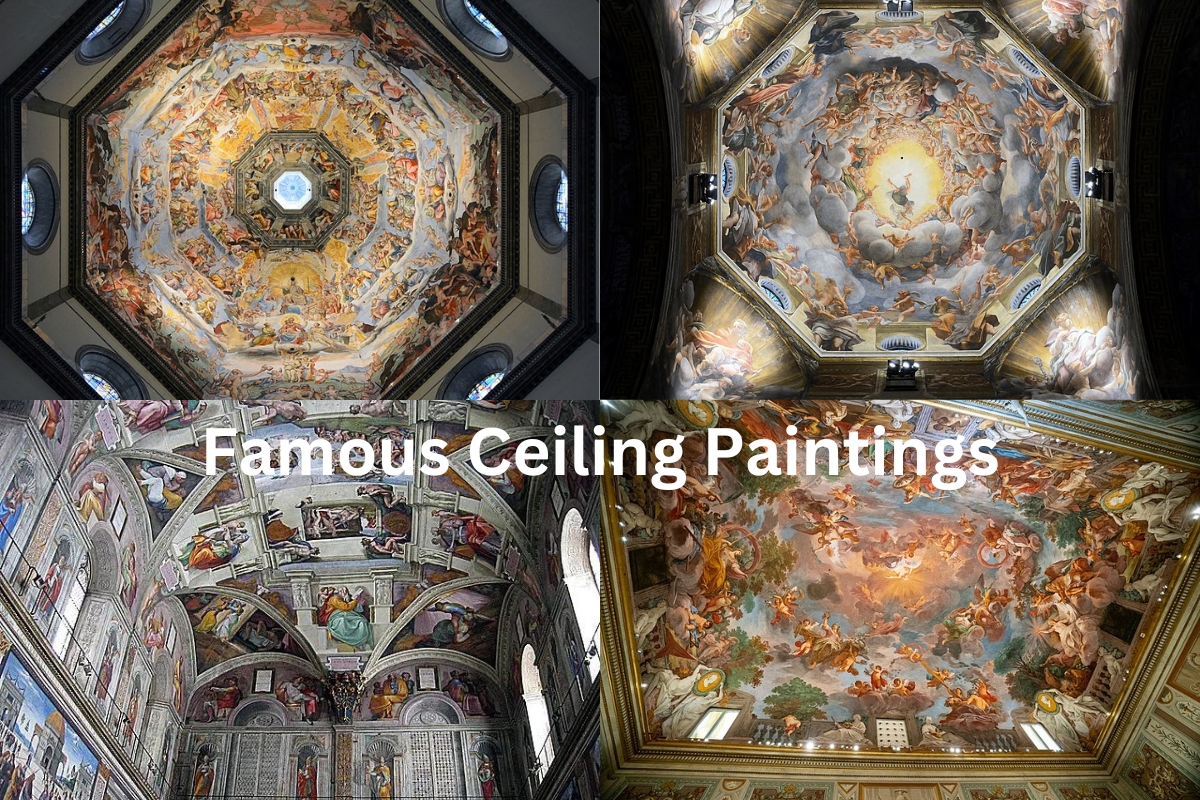Ceiling paintings has been used to primarily decorate the roofs of the great renaissance cathedrals and to a lesser extent palaces and homes of the wealthy.
Frescoes, mosaic tiles, and other surface treatments are common methods used to create these great wonders.
A decorated ceiling has the benefit of being substantially shielded from finger and dust damage, but it is difficult to perform (at least in situ).
While the ceiling of the Sistine Chapel by Michelangelo is certainly among the most well-known in the world, there are many more historic structures with similarly lauded ceilings.
As a tradition in Renaissance, Baroque, and Rococo art, illusionistic ceiling painting uses “trompe l’oeil,” perspective tools like foreshortening, and other spatial effects to create the illusion of three-dimensional space on an otherwise two-dimensional or mostly flat ceiling surface above the viewer.
Common examples include the oculus in Andrea Mantegna’s “Camera degli Sposi,” and the cupola in one of Andrea Pozzo’s “Frescoes of Sant’Ignazio” in Rome, both of which give the impression of a skylight.
Famous Ceiling Paintings
1. Sistine Chapel Ceiling – Michelangelo
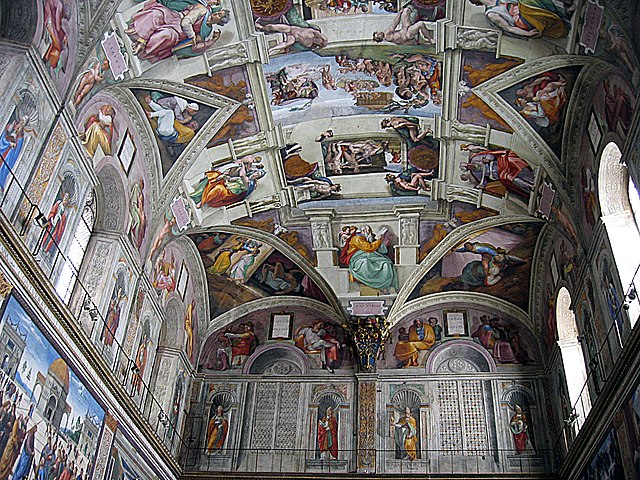
The Creation of Adam, the central work on the Sistine Chapel ceiling, is more well-known than the other paintings, although the entire ceiling is more magnificent.
Michelangelo completed the ceiling of the Sistine Chapel (IVolta della Cappella Sistina) between 1508 and 1512. This masterpiece exemplifies the highest standards of the Renaissance era.
Also Read: Rome Museums
The ceiling artwork was commissioned by Pope Julius II. Papal conclaves and other important events continue to take place at the chapel to this day.
The nine scenes depicted on the ceiling are all taken from the Book of Genesis, with the most well-known being Adam’s creation.
The complex pattern features various groups of persons, both clothed and unclothed, allowing Michelangelo to display his skill in creating a wide variety of poses for the human form and acting as an extremely important pattern book of models for other artists ever since.
To complete the monumental work, Michelangelo painted while lying flat on his back from scaffolding erected beneath the ceiling.
2. Salon d’Hercule – Palace of Versailles
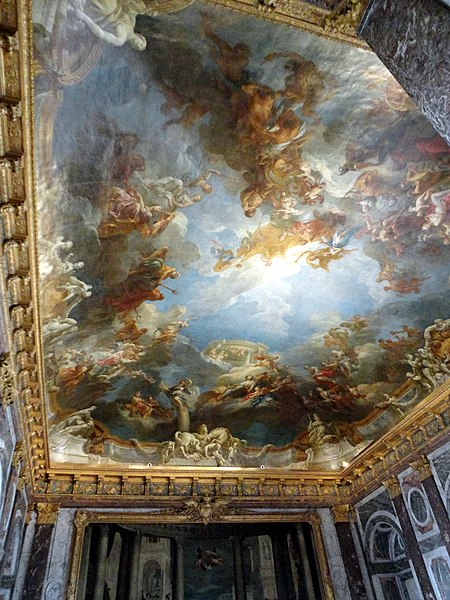
Located on the ground floor of the château, the Salon d’Hercule (also spelled Hercules Salon or Hercules Drawing Room) serves as a passageway between the royal chapel in the château’s North Wing and the grand appartement du roi.
Located on the tribune level of what was once the fourth and penultimate chapel, the salon d’Hercule is now the most prominent feature of the room.
Built in 1710 by Robert de Cotte for Louis XIV, the chamber was first known as the nouveau salon près de la chapelle (new salon near the chapel). The project was put on hold after Louis XIV’s death in 1715.
Construction of the salon d’Hercule resumed in 1724. Louis XV hired Jacques Gabriel, an architect; Claude-Félix Tarlé, a marbrier; Jacques Verberckt, a sculptor; and François-Antoine Vassé, a sculptor, to finish the space.
The ceiling painting Apothéose d’Hercule (Apotheosis of Hercule) by François Lemoyne was completed in 1736 and is responsible for the room’s current name.
3. Camera degli Sposi – Andrea Mantegna
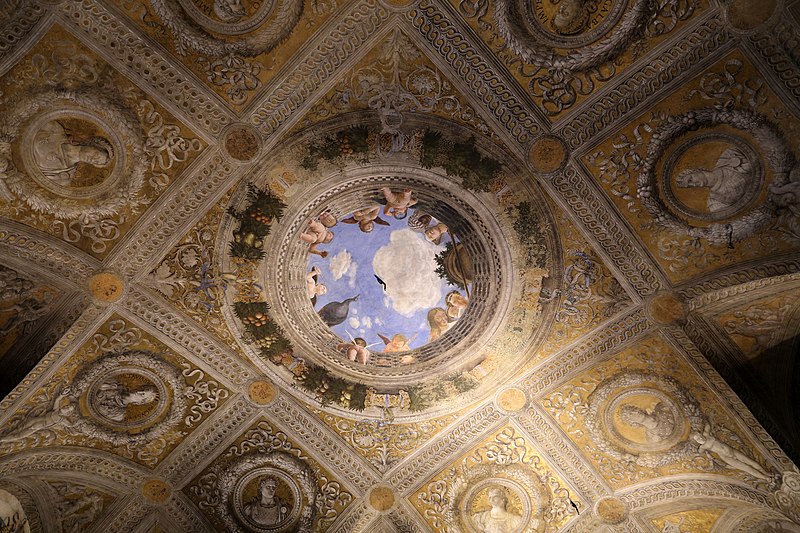
Located in the Ducal Palace of Mantua, Italy, Andrea Mantegna created a series of illusionistic frescoes in a room known as the Camera degli Sposi (or “bridal chamber”), sometimes known as the Camera picta (“painted chamber”).
The Camera degli Sposi, painted between 1465 and 1474, quickly gained notoriety as a masterwork of “trompe-l’oeil” and “di sotto in sù” (two illusionistic painting methods).
While the ceiling is the focal point of the room, each wall features a different scenario that was painted with great artistry.
Foreshortened putti(cherubs) cavort about a railing painted in “di sotto in sù” to make it seem as if they occupy real space on the roof above in Mantegna’s whimsical ceiling depicting an oculus that fictitiously opens into a blue sky.
A stark contrast to the characters in the scenes below, the courtiers peering over the balustrade appear to be fully aware of the viewer’s presence.
Mantegna introduced a novel concept to Renaissance Italy: the idea that artworks might change their appearance in response to the presence of the viewer.
The illusionistic ceiling of the Camera degli Sposi also established a new standard for “di sotto in sù” ceiling paintings, which in turn influenced the ceiling paintings of Correggio and other Baroque artists.
4. “The Assumption” by Jean-Baptiste Pierre – Church of Saint-Roch, Paris
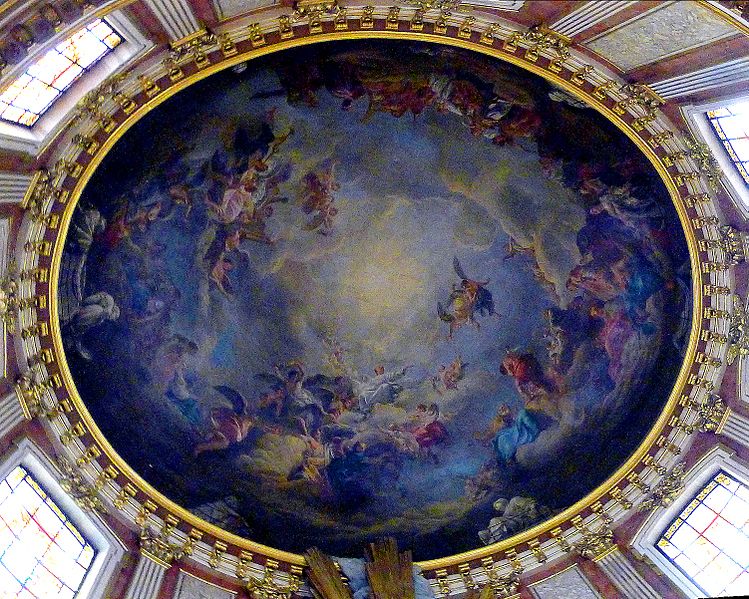
Dedicated to the patron saint of Paris, the 17th-18th century Church of Saint-Roch was built in a Baroque and classical style. It’s in the 1st arrondissement at 284 rue Saint-Honoré. Current church structure was constructed between 1653 and 1740.
The church’s chapels from the 18th century are especially noteworthy for the lavishness with which they employ Baroque murals, sculpture, and architectural details.
The 13 Vendémiaire, which took place in front of the church toward the conclusion of the French Revolution in 1795, saw the young artillery commander Napoleon Bonaparte use a battery of guns to disperse a group of Royalist soldiers who were threatening the new revolutionary authority.
François Mansart was also responsible for the design of the Chapel of the Virgin, which can be found to the north of the Choir. Architecturally and aesthetically, it stands out as a key example of French Baroque art.
It has a large oval dome with an Assumption by Jean-Baptiste Pierre painted on it (1714-1789). Denis Diderot, co-author of the original Encyclopédie, attacked this work for being out of date, but it was lauded at the time by more traditional critics.
5. The Last Judgement by Vasari and Zuccari – Florence Cathedral
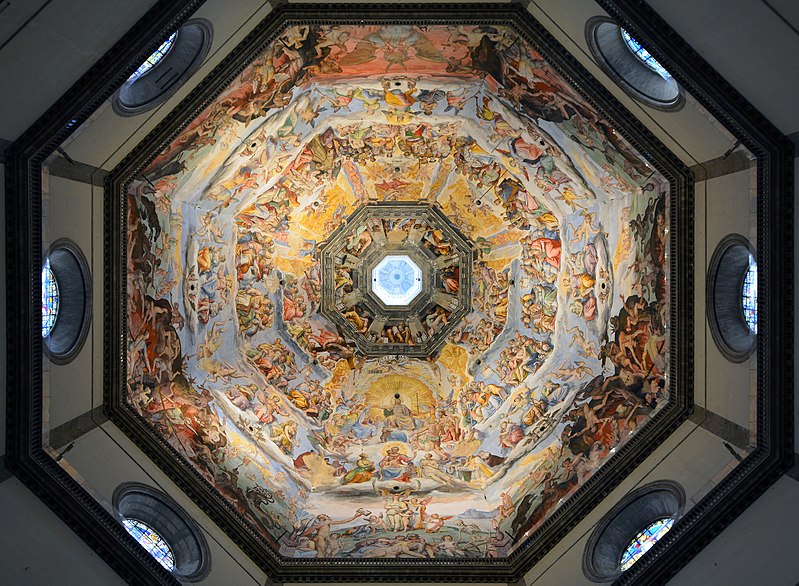
The fresco painting known as The Last Judgment may be found in the Cattedrale di Santa Maria del Fiore in Florence, Italy. It was began in 1572 by the Italian Renaissance master Giorgio Vasari, and it was finished in 1579 by Federico Zuccari, after Vasari’s death.
It was originally commissioned by Grand Duke Cosimo I de’ Medici, and it can be found above the dome of the church. It was the subject of a significant restoration that was carried out during the years of 1989 and 1994.
The frescos are spread out about 10,500 square feet (980 m2).
The composition of the picture includes five layers that are concentric to one another and eight triangles (spicchi).
6. Blue Mosque, Istanbul, Turkey
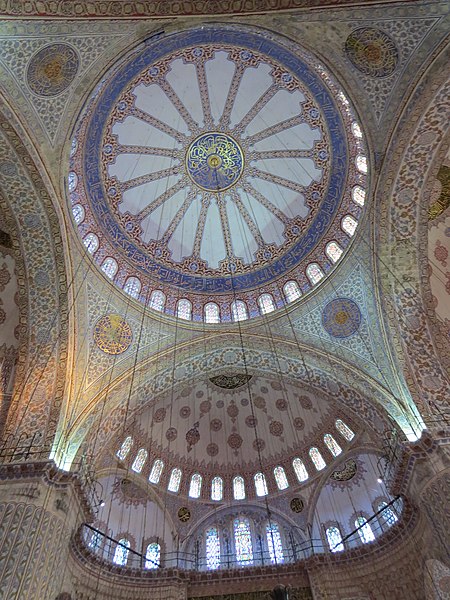
The Sultan Ahmed Mosque, more often known as the Blue Mosque in Istanbul, is an Ottoman-era historical imperial mosque that can be seen in Istanbul, Turkey. Its official name is the Sultan Ahmed Mosque.
In addition to being a working mosque, it is frequently visited by a significant number of tourists. During the reign of Ahmed I, the building was erected between the years 1609 and 1616.
Within its Külliye are located a madrasah, a hospice, and the grave of Ahmed. The inner walls of the mosque are covered in blue tiles that have been hand-painted, and at night the mosque is illuminated in blue thanks to lights that frame the structure’s five main domes, six minarets, and eight subordinate domes.
It lies adjacent to the Hagia Sophia, which was the most important mosque in Istanbul prior to the construction of the Blue Mosque and is also a very well-known tourist destination.
Under the title “Historic Areas of Istanbul,” the Blue Mosque was listed on the list of UNESCO World Heritage Sites in the year 1985.
7. Vatican Gallery of Maps – Ignazio Danti
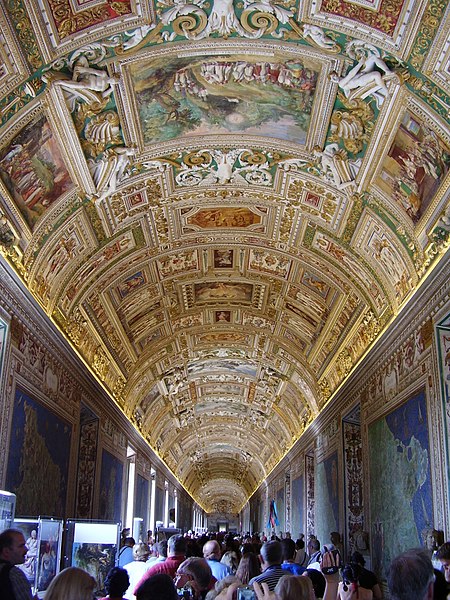
Located on the west side of the Belvedere Courtyard in the Vatican, the Gallery of Maps displays a collection of painted topographical maps of Italy created from the sketches of Franciscan and geographer Ignazio Danti.
In 1580, Pope Gregory XIII commissioned the gallery as part of a larger project to beautify the Vatican with works of art. It took Danti three years (1580–1583) to create the 40 panels of the 120 m long gallery.
The panels map the entirety of the Italian peninsula in large-scale paintings, each representing a region as well as a perspective view of its most notable city. There is an alleged 80% degree of accuracy with these maps.
A group of Mannerist artists, including Cesare Nebbia and Girolamo Muziano, decorated the high ceiling.
8. Borghese Gallery Ceiling Painting
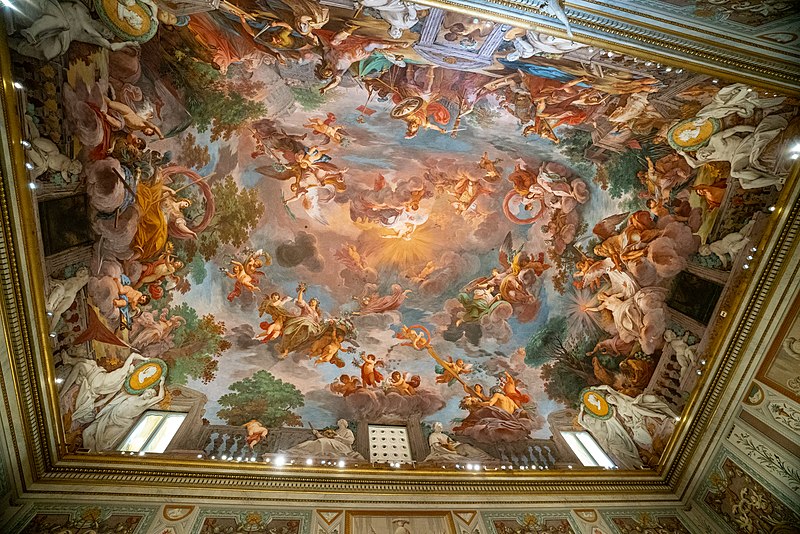
Located in what was once the Villa Borghese Pinciana, the Galleria Borghese in Rome, Italy, is a museum of art. The grounds at Villa Borghese were originally designed to complement the gallery architecture, but today they are visited by tourists on their own.
Founded by Cardinal Scipione Borghese, the nephew of Pope Paul V, the Borghese Collection of paintings, sculpture, and antiquities is on display at the Galleria Borghese (reign 1605–1621).
Flaminio Ponzio built the structure based on designs by Scipione Borghese, who lived in it as a villa suburbana (a country mansion on the outskirts of Rome).
Twenty rooms spread out over two stories make up the Galleria Borghese.
Main floor exhibits focus on classical antiquities from the 1st to 3rd centuries AD, including a famous mosaic of gladiators from 320-30 AD discovered in 1834 on the Borghese estate at Torrenova, on the Via Casilina outside Rome.
The first chamber of the Salone, the major huge space on the ground floor, features a gigantic trompe-l’oeil ceiling fresco by the Sicilian artist Mariano Rossi, who makes such effective use of foreshortening that his work appears practically three-dimensional.
The Gaulish siege of the Capitoline Hill is broken in this painting by Marcus Furius Camillus. Pietro Rotari painted the grotteschi ornaments, while Venceslaus Peter Boemo did the animal ornaments.
The Camera di Cerere is the first room off the Salone, and it features a marble vase of Oedipus and the Sphinx. The Fall of Phaeton, by Francesco Caccianiga, is depicted on the ceiling of the second room. Bernini’s Apollo and Daphne can be found in the third room.
9. Triumph of the Name of Jesus – Church of the Gesù, Rome
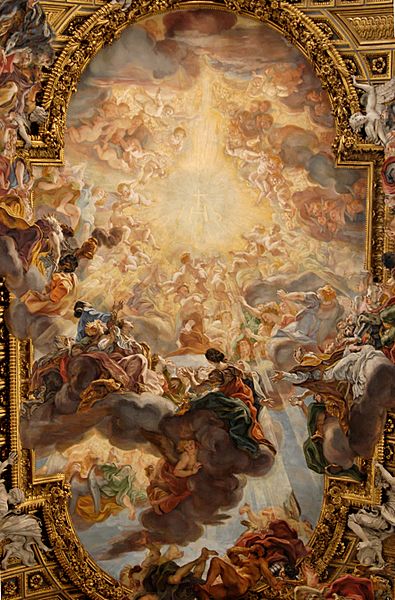
The fresco painting Triumph of the Name of Jesus was created by Giovanni Battista Gaulli in the 17th century. Both the fresco painting and the stucco molding are located in the nave of the Il Gesu.
Saint Paul’s account of the Adoration of the Name of Jesus inspired the topic of Gaulli’s ceiling fresco.
His remarks hang on a ribbon beyond the building’s borders. The spreading of faith is the central theme of these words, which provide context for Gaulli’s painting. The Jesuits sought to improve worship by adding a calmness of mind and spirit akin to meditation.
The cathedral-like vaulted ceiling wasn’t built only for show; it was designed to improve worship. The Jesuits put a premium on the ability of the congregation to hear every word of the discourse.
Since this was the case, a dome was placed over the intersection of the nave and transept. The drastic disruption of the three-dimensional frame is one of Gaulli’s most original contributions. This gives the idea that the heavenly figures above have an actual presence in the church, as if they are floating directly over the viewers’ heads.
The depth achieved in the fresco stretches past the physical ceiling, leading the blessed upward into the endless sky. Adding a bold stucco border around his fresco, Gaulli emphasizes the optical separation of the vault’s inside and exterior.
When viewed from a distance, a fresco can easily be mistaken for stucco molding. Because of this, the audience is more likely to believe that spirits are actually floating upwards and downwards before their very eyes.
10. Assumption of the Virgin – Cathedral of Parma
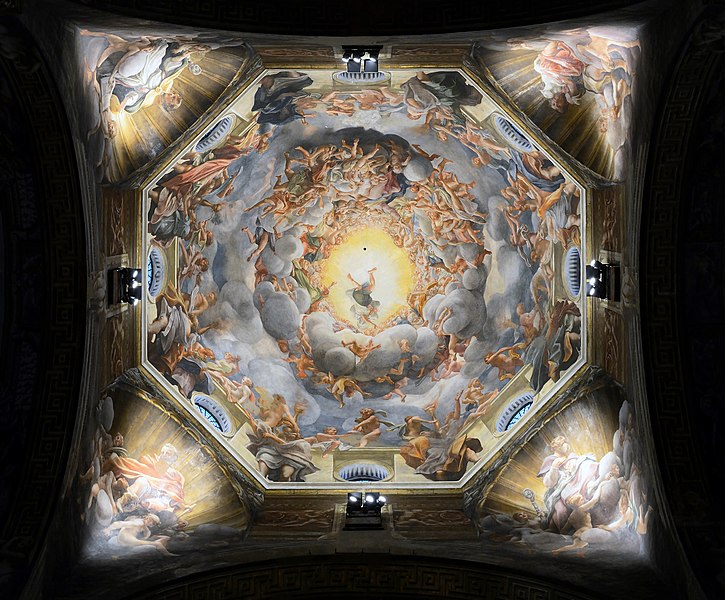
Located in the dome of the Cathedral of Parma, Italy, Antonio da Correggio’s The Assumption of the Virgin dates back to the Italian Late Renaissance.
On November 3, 1522, Correggio put pen to paper on the agreement to commission the painting. Construction of it ended in 1530.
The dramatic illusionism of the “di sotto in su” ceiling paintings of the 17th-century Baroque period owe a great deal to Correggio’s Assumption.
Both Correggio and his Baroque successors link the dome of a church with the vault of heaven by depicting the full surface of the building as an unified pictorial element of immense proportions.
The use of foreshortening to make the figures appear to project into the space around the viewers was revolutionary at the time, but became standard practice for Baroque artists who focused on illusionistic vault decorating.

